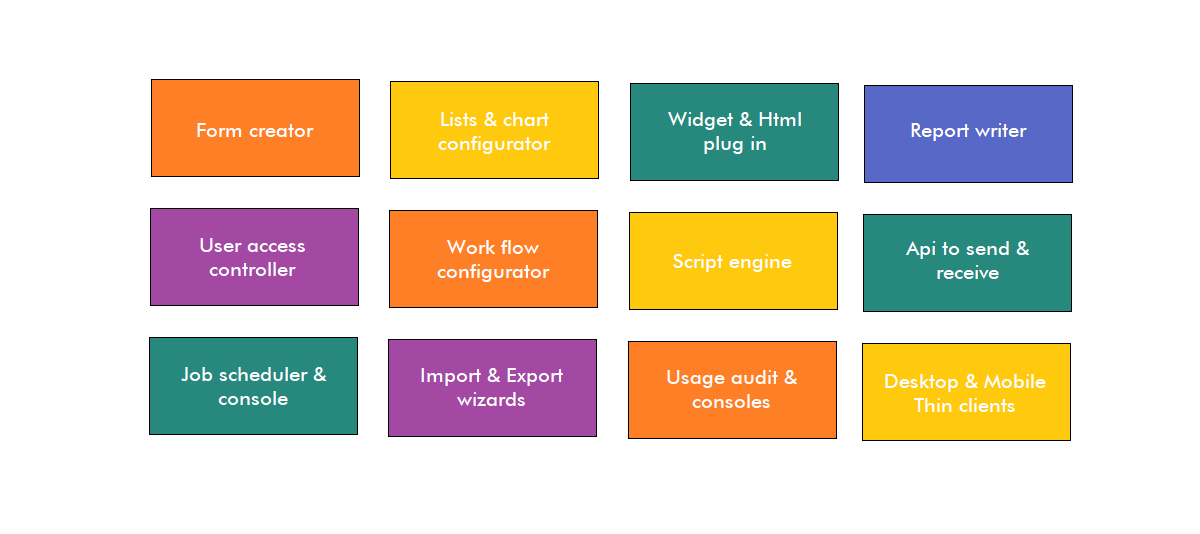Axpert 11
TStructs (Forms)
- Create Form
- Create DC
- Create Fields
- Grid DC/frames
- Formulae in fields
- SQL in fields
- Drop down fields
- Autogenerate fields
- Table fields
- File upload fields in forms
- Photos &Image fields
- Barcode /QR Code Scanner
- Fill Grid
- Posting data – Gen maps
- Updating fields in DB tables – MD Map
- Toolbars in tstructs
- Tracking changes/Audit trial
- Try it yourself
IViews
Scripts
Axpert Jobs
Axpert Cards
HTML Plug-ins
Users & Roles
- Users, roles & responsibilities
- Responsibilities
- User Role
- User Login
- SSO Authentication
- Stay Sign In
Workflow
Axpert API
Application Var/Params
Publish Axpert Apps
Axpert Mobile
Settings
- Axpert installation
- Change password
- Forgot Password
- Developer Options
- Global Settings
- In-Memory DB
- Notifications for Long Running Webservice’s
- Axpert Configuration on web
- Axpert Licensing
Utilities
Customization
- Main Page Customization
- Home Page Customization
- More API
- Custom User Interface
For Reports - Custom HTML In Forms
- CSS And JS Customization
- Developer Notes
- Hooks In Forms
- Third Party SSO Integration
WebServices
Axfast
Agile Developer
Here is a short Axpert Introduction video for you to check out,
- Introduction
- Possibilities with Axpert
- Main components in Axpert
- Understanding the concept behind Axpert
Introduction
Axpert is a widely used low code application platform across many countries. Apps are created using Axpert, just by defining the data structures. There is no need to write programs in multiple layers. Agile owns the patent for this concept behind Axpert.
Axpert is best suited for requirements that are data-centric with complex processes that need to manage large volumes of data and integrate with other applications.
Whether you’re an experienced developer or someone with little to no coding background, Axpert provides a versatile and user-friendly environment to create robust applications with ease.
For developers seeking to streamline their workflows and accelerate the development cycle, Axpert offers a comprehensive set of tools and features. With its low-code capabilities, seasoned developers can leverage pre-built components, templates, and reusable modules to expedite development, allowing them to focus on more complex and business-critical aspects of their applications.
Novice developers, on the other hand, benefit from Axpert’s no-code approach, eliminating the need for extensive coding knowledge. The platform employs intuitive drag-and-drop interfaces, visual design elements, and simple configuration options, enabling individuals with limited coding experience to participate actively in the development process.
Possibilities with Axpert
Axpert apps can be used on Windows Desktop, Browsers as web applications, and on mobile devices. Axpert apps can be deployed on remote locations with automatic data synchronization.

Main components in Axpert
Axpert apps are built by defining forms, reports, lists, widgets, and writing scripts to achieve some complex tasks. The various utilities and tools that are packed with Axpert development environment enable users to create enterprise-class apps on the fly.
The main components in Axpert developer site are:

You can download Axpert from www.developer.agile-labs.com and install on-premise or on your private cloud. To install Axpert on-premise, follow the instructions provided in the installation & configuration section. This may take several hours.
When Axpert is installed in a server or a cluster of servers, it is called an Axpert Instance (AxIns).
For each application that is to be developed & deployed on Axpert, you should create an AxpertAppschema (AxAS). The data and metadata that are related to the application are stored in the schema.
Axpert is already installed & configured on www.AgileCloud.biz. This is a shared Axpert Instance on the cloud. You can build and host applications on this cloud for your customers. You may also choose to build Axpert apps on AgileCloud and deploy it on-premise too.
Understanding the concept behind Axpert
The basic building block of Axpert is called a transaction structure. A transaction structure (tstruct) is a collection of data elements along with business rules. To develop apps on Axpert, the core entities are identified and represented as transaction structures.
A data element is described by its basic attributes (like type, width, etc..), the rule to populate, and rule to validate. A collection of such data elements become a structure. Data flow from one structure to another is created as maps. The maps are created by connecting data elements in the source structure to the target structure. Special logic that needs to be attached along with data may be attached using Axpert scripts or database procedures and functions. Axpert supports Oracle, MySQL, PostgreSql& MS SQL databases.
For example, in a CRM application, the core entities are prospects, salesperson, customer master & daily activities. In a procure to pay cycle; supplier master, item master, rate contract, purchase request, purchase order, GRN, supplier bills are some of the major tstructs. In a time-sheet application; employee, project master, timesheet, tasks, project milestones are some major tstructs.
The structures are created in Axpert through the developer site. The rest are managed by Axpert run time site. These structures can be accessed as a form in Axpert. In other words, all forms in Axpert are created as tstructs. Once a structure is created, the underlying database tables are automatically created to store the data. Axpert also manages all table relationships and referential integrities.
Axpert core layer is a collection of APIs that provide services around a tstruct. It consists of API for saving data into structures, listing data from structures, searching, getting the menu, managing workflow, data flow, data import, data export, script execution, etc.
Axpert UI layer provides a standard user interface for accessing tstructs as forms, lists, menus, widgets, wizards, data import & export features, user and access control management, and workflow configuration.
Axpert is not a code generator. It has a standard set of APIs that read and execute the logic defined in structures. For example, there is one API called to submit. With this, you will be able to submit data into any structure or form. Therefore, functionalities created in Axpert are available as API that can be consumed by third-party applications. There is no need to write programs or do any additional activity to publish the functionality as web or REST services.




